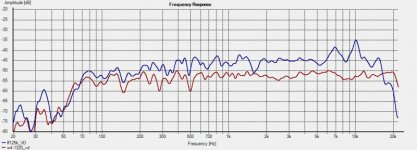Dayton PS95-8 driver
I received the Dayton Audio PS95-8 (point source 3.5in full range) today. It's a a very nicely made driver with superb fit and finish. The cast frame has slender little arms so that it obstructs the back wave as little as possible, there is a copper phase plug, an inverted rubber surround, and gold plated terminals. The cutout is exactly the same as the RS100 so that was very convenient.
Here are some photos of the driver and the new lineup of drivers tested:
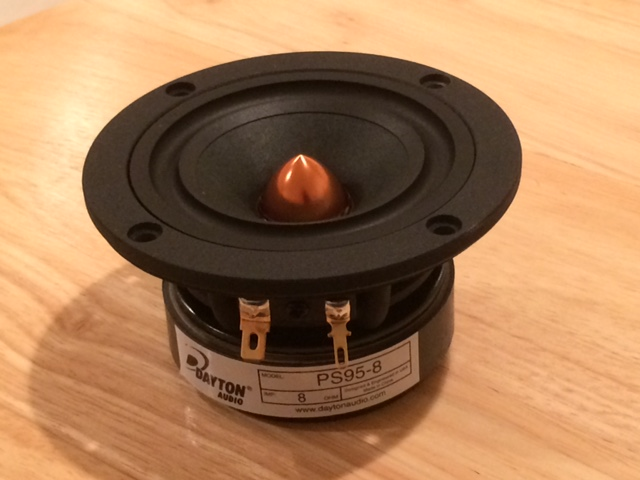
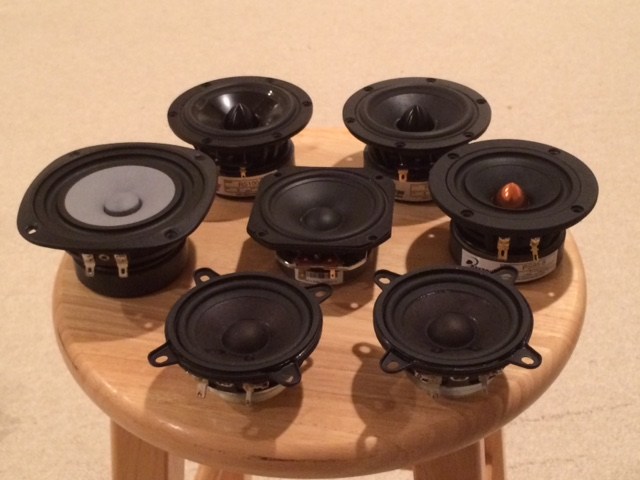
Here is the measured harmonic distortion and frequency response at 12.7cm distance from cone:
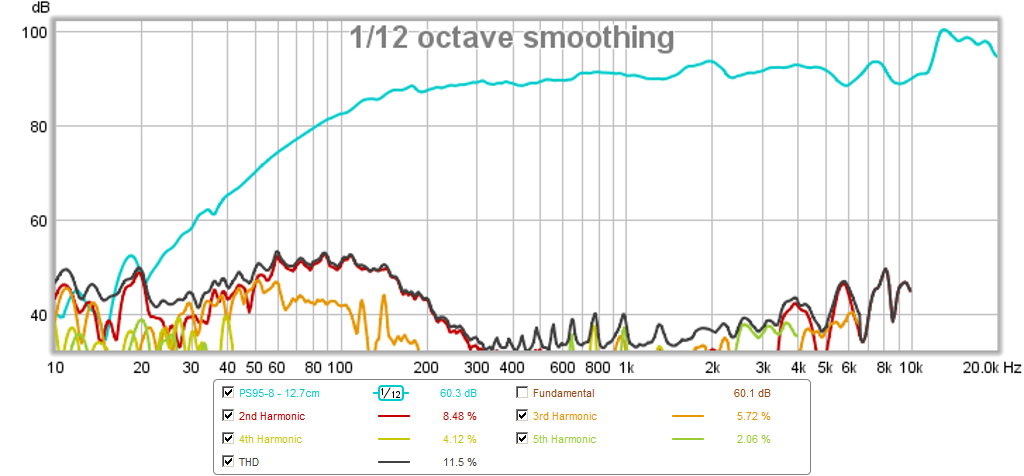
Here is the Impulse Response:
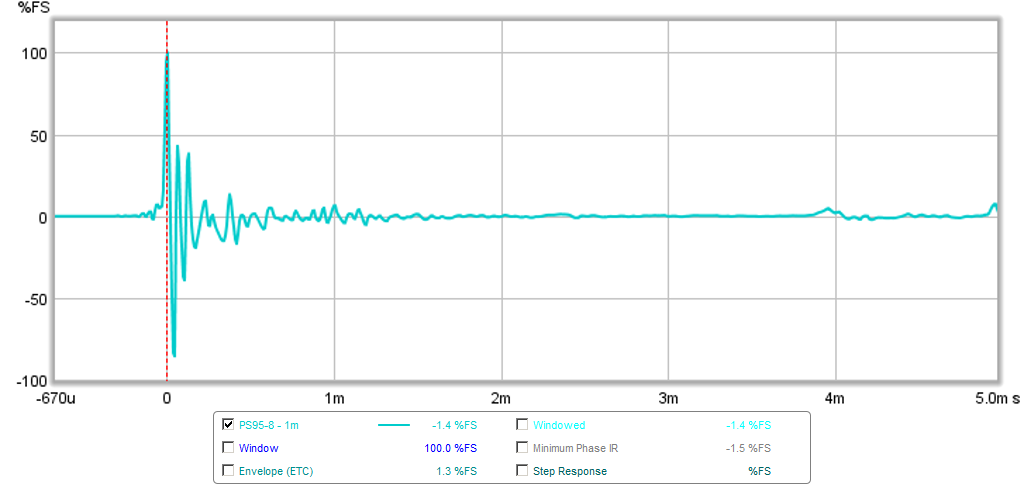
Here is the comparison with the TC9FD - not a bad performance:

Here is the implementation in a FAST with an XKi dual W5-876E as the sub (http://www.diyaudio.com/forums/full-range/268524-xki-xs-ab-initio-karlson-6th-order-bandpass-26.html#post4226956), the is the XO (there will be two soundclips with and without EQ):
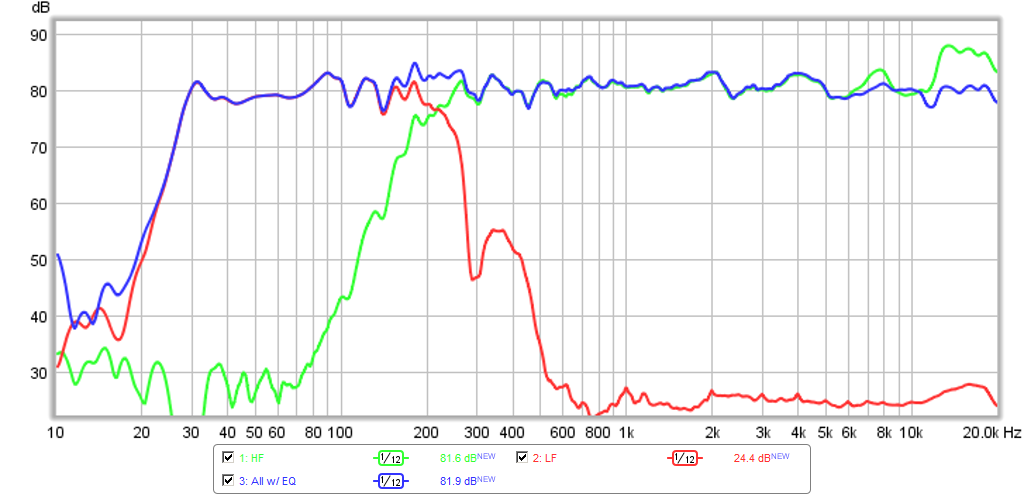
Here is the harmonic distortion:
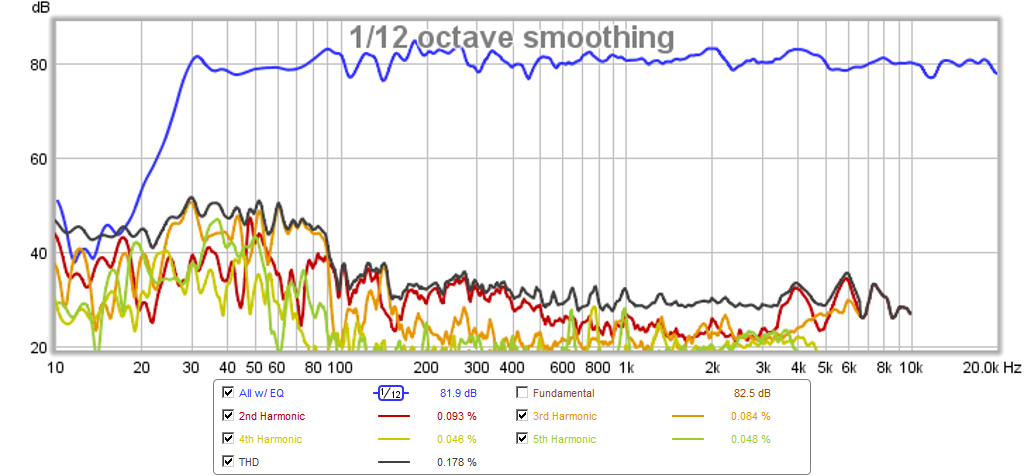
Here is the impulse response:

I received the Dayton Audio PS95-8 (point source 3.5in full range) today. It's a a very nicely made driver with superb fit and finish. The cast frame has slender little arms so that it obstructs the back wave as little as possible, there is a copper phase plug, an inverted rubber surround, and gold plated terminals. The cutout is exactly the same as the RS100 so that was very convenient.
Here are some photos of the driver and the new lineup of drivers tested:


Here is the measured harmonic distortion and frequency response at 12.7cm distance from cone:

Here is the Impulse Response:

Here is the comparison with the TC9FD - not a bad performance:

Here is the implementation in a FAST with an XKi dual W5-876E as the sub (http://www.diyaudio.com/forums/full-range/268524-xki-xs-ab-initio-karlson-6th-order-bandpass-26.html#post4226956), the is the XO (there will be two soundclips with and without EQ):

Here is the harmonic distortion:

Here is the impulse response:

Attachments
-
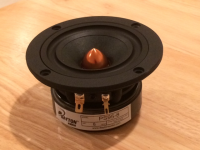 PS95-8-photo-01.png354.5 KB · Views: 8,134
PS95-8-photo-01.png354.5 KB · Views: 8,134 -
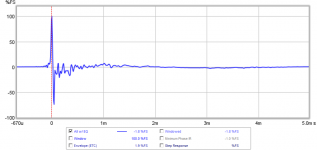 ps95-xki-fast-ir.png39.2 KB · Views: 7,021
ps95-xki-fast-ir.png39.2 KB · Views: 7,021 -
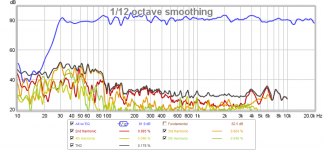 ps95-xki-fast-hd.png162.5 KB · Views: 7,721
ps95-xki-fast-hd.png162.5 KB · Views: 7,721 -
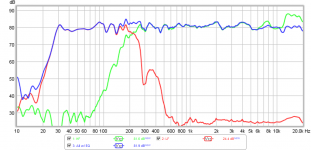 ps95-xki-fast-xo.png96.4 KB · Views: 7,737
ps95-xki-fast-xo.png96.4 KB · Views: 7,737 -
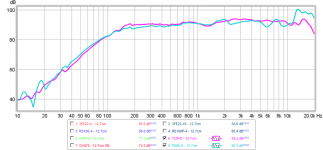 tc9fd-vs-ps95-8-12.7cm-freq.png60.6 KB · Views: 7,303
tc9fd-vs-ps95-8-12.7cm-freq.png60.6 KB · Views: 7,303 -
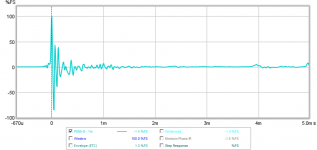 ps95-8-1m-ir.png44.3 KB · Views: 7,720
ps95-8-1m-ir.png44.3 KB · Views: 7,720 -
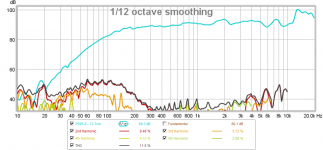 ps95-8-hd-12.7cm.png116.2 KB · Views: 7,250
ps95-8-hd-12.7cm.png116.2 KB · Views: 7,250 -
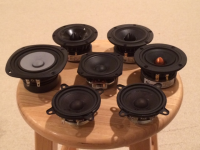 PS95-8-photo-3-lineup.png392.3 KB · Views: 19,386
PS95-8-photo-3-lineup.png392.3 KB · Views: 19,386 -
PS95-XKi-FAST-no-EQ.zip870.9 KB · Views: 339
-
PS95-XKi-FAST-w-EQ.zip870.6 KB · Views: 288
Last edited:
Morning everyone.
Thank you xrk for taking the time and doing relentless work to compare the small fullrangers!
From tests in german diy hifi magazins and listening experience if have concluded that there is a lot of "ringing" with many metal cone drivers. With a steep xo +notch filter it usually poses little problems to eliminate the resonances from the pass band but to implement the resonating metal cone as a full range driver seems to be much more "difficult"...
I find the zing of the resonances gets annoying and as pnix states over in the thread about In-Room measurments the subharmonic distortions influence the other frequencies also.
So only with many many hours of listening ("break in") does the brain-ear get acoustomed enough to the "rininging" quality that it bothers less + less
Not my way to go...
Regards and thanks again for your work xrk!
Thank you xrk for taking the time and doing relentless work to compare the small fullrangers!
From tests in german diy hifi magazins and listening experience if have concluded that there is a lot of "ringing" with many metal cone drivers. With a steep xo +notch filter it usually poses little problems to eliminate the resonances from the pass band but to implement the resonating metal cone as a full range driver seems to be much more "difficult"...
I find the zing of the resonances gets annoying and as pnix states over in the thread about In-Room measurments the subharmonic distortions influence the other frequencies also.
So only with many many hours of listening ("break in") does the brain-ear get acoustomed enough to the "rininging" quality that it bothers less + less
Not my way to go...

Regards and thanks again for your work xrk!
yup.
Ya can notch 3khz, but the 1.5khz has a harmonic of 3khz, and away the driver starts resonating.
A buddy of mine suspects that any energy into the cone will cause a driver to resonate at those higher frequencies.
Norman
Ya can notch 3khz, but the 1.5khz has a harmonic of 3khz, and away the driver starts resonating.
A buddy of mine suspects that any energy into the cone will cause a driver to resonate at those higher frequencies.
Norman
Stretching the truth Mr X? You got reasons why LF measurements were not very useful and potentially misleading. HF measures will be substantially the same as those made elsewhere in different boxes.
dave
My mistake. The word was "meaningless" not "worthless".
From: http://www.diyaudio.com/forums/full-range/269509-limitations-not-current-speaker-measurement-technology.html#post4203151
Low distortion -- in the all-encompassing sense -- should be as low as possible. But we have no way to quantify that, according to Geddes' experiment, what we currently measure is meaningless. So you can make no judgements on quality based on the graphs people post
From: http://www.diyaudio.com/forums/full-range/269391-usefulness-room-lf-measurements-vs-no-measurements-ref-fh.html#post4206036
The speaker is designed to use the room. And the question is about the difference in the LF.It will be room dependent. Take the room out and the measurement is meaningless.
Morning everyone.
Thank you xrk for taking the time and doing relentless work to compare the small fullrangers!
...
Regards and thanks again for your work xrk!
Sayrum,
You are welcome! Who would have guessed that the first fullrange driver I decided to play with over 2 years ago, based on a post you pointed me out to on the flat wall mounted Vifa TL, would turn out to be perhaps one of the best 3.5in to 4.0in fullrange drivers out there at any price? It is not until I set many drivers next to it side by side in an apples-to-apples comparison with quantitative data that it is quite clear just how good it is. The performance is remarkable and a testament to the development and engineering that Peerless/Vifa put into this unit. Having built more than a dozen speakers (and perhaps 8 different alignments) with this driver, I also know that it is very versatile. As Wesayso has shown, stack 50 of them together with some EQ and you have a world class system.
There are still a few drivers left (A7.3, FF85wk, to name a few) that some will argue are better. Until I get them in hand and tested, based on the results so far, I would say TC9FD is still the leader. The A7.3 and FF85wk are clearly in a different price point category, so maybe the distinction could be that in the sub $40 for the 3in-4in class fullrange driver, the TC9FD is still the king.
Last edited:
That 3" bamboo-cone TB might give these guys a run for their money, if it's anything like its 4" sibling. W4-1320SIF is the red trace, with FF125K on blue.
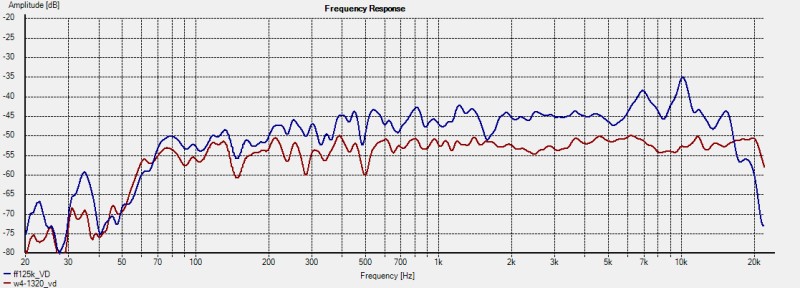
The response above ~500Hz (probably about where I had the gate) fits in a 5dB window to 20kHz. 🙂 Your test conditions would probably make for a smoother bottom end as well.
The response above ~500Hz (probably about where I had the gate) fits in a 5dB window to 20kHz. 🙂 Your test conditions would probably make for a smoother bottom end as well.
Attachments
New Thread for Objective Comparison of 3in to 4in Drivers
I spun off a new thread for the comparisons here:
http://www.diyaudio.com/forums/full-range/270094-objective-comparison-3in-4in-class-full-range-drivers.html#post4230972
I spun off a new thread for the comparisons here:
http://www.diyaudio.com/forums/full-range/270094-objective-comparison-3in-4in-class-full-range-drivers.html#post4230972
That 3" bamboo-cone TB might give these guys a run for their money, if it's anything like its 4" sibling. W4-1320SIF is the red trace, with FF125K on blue.

The response above ~500Hz (probably about where I had the gate) fits in a 5dB window to 20kHz. 🙂 Your test conditions would probably make for a smoother bottom end as well.
IG81,
Thanks for posting results of TB Bamboo. Godzilla will send me a 4in version when he returns next weekend. I did not know there was a 3in bamboo cone. The FF85Wk looks to have a couple of peaks 7kHz and 10kHz. Not as smooth as paper cones. If anyone has an FF85WK that they would like me to add to this study, I am up for testing it.
IG81,
Thanks for posting results of TB Bamboo. Godzilla will send me a 4in version when he returns next weekend. I did not know there was a 3in bamboo cone. The FF85Wk looks to have a couple of peaks 7kHz and 10kHz. Not as smooth as paper cones. If anyone has an FF85WK that they would like me to add to this study, I am up for testing it.
The blue trace is the old FF125K, not FF85WK. 😉
The TB was in its 6L/3L DCR enclosure and the Fostex in a ~8L BR. The measurements were done at the same time, location, drive level and distance, so the relative sensitivity is exact. Above 70Hz, the FF125K is more sensitive and not by a neglectful amount. Driven by a ~2ohm output Z SEP 6GW8 amp that puts out 2.5W, it makes for a great nearfield computer system.
Measured FR is a great tool, but not everything - nothing new to most of us of course. Despite the better response on the part of W4-1320SIF, I still prefer the FF125K overall. It has better dispersion, imaging and resolution along with a handful of other vaguely meaningful terms I'll spare you. 😀
About FF85WK, I've enjoyed it in a couple of more wacky experimental enclosures, but have yet to find it a proper home. I saw Scottmoose's compact TL design "Lance" and it reminded me of a similar box I had built for a 4.5" Pioneer A11 driver, as well as a tappering TL I had designed for FF165WK as an exercise, a smaller version of which HR has me optimistic about if I choose to ever build it.
Last edited:
Great work. Thanks 🙂
Visaton FRS 8 is also very good at least the sound, I haven't mesure it. If possible get one and add it to your list of drivers https://www.parts-express.com/visaton-frs8-8-33-full-range-speaker-8-ohm--292-524
Visaton FRS 8 is also very good at least the sound, I haven't mesure it. If possible get one and add it to your list of drivers https://www.parts-express.com/visaton-frs8-8-33-full-range-speaker-8-ohm--292-524
Great work. Thanks 🙂
Visaton FRS 8 is also very good at least the sound, I haven't mesure it. If possible get one and add it to your list of drivers https://www.parts-express.com/visaton-frs8-8-33-full-range-speaker-8-ohm--292-524
As well as the FR10 and B80 need to be considered.
Morning everyone.
Thank you xrk for taking the time and doing relentless work to compare the small fullrangers!
From tests in german diy hifi magazins and listening experience if have concluded that there is a lot of "ringing" with many metal cone drivers. With a steep xo +notch filter it usually poses little problems to eliminate the resonances from the pass band but to implement the resonating metal cone as a full range driver seems to be much more "difficult"...
I find the zing of the resonances gets annoying and as pnix states over in the thread about In-Room measurments the subharmonic distortions influence the other frequencies also.
So only with many many hours of listening ("break in") does the brain-ear get acoustomed enough to the "rininging" quality that it bothers less + less
Not my way to go...
Regards and thanks again for your work xrk!
Regarding the RS100-4, I have used DSP eq to reduce the level of ringing to the point where it is essentially a nonissue, and I run it fullrange with great results.
yup.
Ya can notch 3khz, but the 1.5khz has a harmonic of 3khz, and away the driver starts resonating.
A buddy of mine suspects that any energy into the cone will cause a driver to resonate at those higher frequencies.
Norman
The RS100-4 rings at ~15k yet shows lower harmonic distortion in the 7k-8k range than the paper cone version.
You can see Zaph's measurements here for the RS100. First is his frequency response showing the peaking in the top octave.

And here is the harmonic distortion. You can clearly see the peaking in 3rd, 4th and 5th harmonics as a result. You need measurements of a certain type to make it visible and measurements done at certain drive levels to get the SnR up high enough that you can see all the details.

Not all metal cones show this kind of behaviour, but it depends how stiff the cone is. The lighter and thinner the cone the less like a rigid metal it will behave.

And here is the harmonic distortion. You can clearly see the peaking in 3rd, 4th and 5th harmonics as a result. You need measurements of a certain type to make it visible and measurements done at certain drive levels to get the SnR up high enough that you can see all the details.

Not all metal cones show this kind of behaviour, but it depends how stiff the cone is. The lighter and thinner the cone the less like a rigid metal it will behave.
Thanks, I came across this while researching small drivers a while back. Also see the following direct comparison of the RS100 aluminum and paper version:
http://www.diyaudio.com/forums/full...n-class-full-range-drivers-9.html#post4231956
http://www.diyaudio.com/forums/full...n-class-full-range-drivers-9.html#post4231956
As well as the FR10 and B80 need to be considered.
FR 10 has a bit too much of midrange for my taste so I don't see it as a driver sutible for fullrange operation. B 80 I thing has been documented enought so no need to do it, unles you get it for free or just for testing.
I have TB bamboo 3" (old ferrite version) and 4", for me 3" is better and among top in that size, 4" lacks HF...
Yellow Vifa 3" (known in Picollino Box) https://www.hifi-selbstbau.de/daten...-hifi-selbstbau/workshops/60-vifa-10-bgs-1198 has the most mesmerising vocals in 3" department and ease of listening, but needs helper tweeter (at about 6Khz or higher) to be complete, it has the same fullness and magic like TB 5" polycone (now there is new 5" paper version that I have to buy because its simply the best value ever http://www.ebay.de/itm/2x-Tang-Band...fe6ea4f&pid=100011&rk=3&rkt=7&sd=361217298263 ).
Alpair 7 is good to very good, but sometimes the metal membrane character can be heard/recognised.
CHP70 not bad, could be good with supertweeter but didn't experimented yet.
Compared to other 3" I don't like:
Scan-Speak 10F/4424G00, for me it's lifeless and also lacks HF, its a midrange
Faital 3FE20 (me thinks it's the same as 3FE22) has some nasty stuff in vocals, very unlistenable, toe in doesn't help
PS: Just acquired 2 pairs of these 😀
http://www.ebay.de/itm/2x-Miller-am...XT77fu6pO62e6XKFhTJcA%3D&orig_cvip=true&rt=nc
Yellow Vifa 3" (known in Picollino Box) https://www.hifi-selbstbau.de/daten...-hifi-selbstbau/workshops/60-vifa-10-bgs-1198 has the most mesmerising vocals in 3" department and ease of listening, but needs helper tweeter (at about 6Khz or higher) to be complete, it has the same fullness and magic like TB 5" polycone (now there is new 5" paper version that I have to buy because its simply the best value ever http://www.ebay.de/itm/2x-Tang-Band...fe6ea4f&pid=100011&rk=3&rkt=7&sd=361217298263 ).
Alpair 7 is good to very good, but sometimes the metal membrane character can be heard/recognised.
CHP70 not bad, could be good with supertweeter but didn't experimented yet.
Compared to other 3" I don't like:
Scan-Speak 10F/4424G00, for me it's lifeless and also lacks HF, its a midrange
Faital 3FE20 (me thinks it's the same as 3FE22) has some nasty stuff in vocals, very unlistenable, toe in doesn't help
PS: Just acquired 2 pairs of these 😀
http://www.ebay.de/itm/2x-Miller-am...XT77fu6pO62e6XKFhTJcA%3D&orig_cvip=true&rt=nc
Last edited:
I have TB bamboo 3" (old ferrite version) and 4", for me 3" is better and among top in that size, 4" lacks HF...
I have the 4" ferrite motor bamboo and really like this driver. I measure it to have a smooth on-axis response to 20kHz, but I do feel it very quickly looses HF output when moving off-axis, so I agree it does have a poor power response.
The 4" bamboo I have is with neodym magnet, but for me also on axis it's too dark, there is missing energy and liveness in HF altough it looks ok in measurement... TB 5" polycone has even darker character but it's different, has fullness and overall presentation is superb, it's like emotional vortex that sucks you in, but the downside is that it beams like no other FR that I heard, it's because the shape of cone is very deep...
(Forgot to mention one 3" that I really hate, it's not because of it's artificial sound alone, but more because of all the hype and masshypnosis use, it's the silver TB W3-871)
(Forgot to mention one 3" that I really hate, it's not because of it's artificial sound alone, but more because of all the hype and masshypnosis use, it's the silver TB W3-871)
Last edited:
The 4" TB bamboo driver has a rolled off treble to my ears too even tho it measures relatively flat on axis. Off axis treble rolls off. There appears to be a consensus on it's sound which might imply that they are built to consistent standards. It's a nice driver with a sonic signature. If you lie a darker sound try it. If you like a brighter sound try something else like a Fostex, which also appears to have consistent subjective reviews. They both are flawed and people will prefer one or the other.
Other manufacturers, like Alpair, Vifa, etc. have their own sonic signatures. We can select any one we want. Each offers something different.
But the measurements are critical to understanding why drivers sound the way they do so we can bring DIY to a higher level. I enjoy viewing the frequency charts but since the thread has been split I'm not sure where to post.
Regargless, I'm for further techical investigation. The BIB spreadsheet took the gueswork out of building a nice backhorn. Time, patience, testing and more testing brought about wonderful opportunities to build something excellent. Without the work we did as a community, without the discussions, we might still be guessing and arguing. A BIB is flawed just like any other speaker but moved us in the right direction. Measuring drivers and sharing our listening impressions will, as a community of DIYers, help us build better sounding speakers - tailored to our preferences - because there is no perfect speaker at the moment and differences vary widely.
I wonder if investigating measurements might lead to optimal cone shapes... different cone shapes? Regardless, I reserve the right to listen to any driver I choose.
Thanks for everyone's opinions and insights.
Other manufacturers, like Alpair, Vifa, etc. have their own sonic signatures. We can select any one we want. Each offers something different.
But the measurements are critical to understanding why drivers sound the way they do so we can bring DIY to a higher level. I enjoy viewing the frequency charts but since the thread has been split I'm not sure where to post.
Regargless, I'm for further techical investigation. The BIB spreadsheet took the gueswork out of building a nice backhorn. Time, patience, testing and more testing brought about wonderful opportunities to build something excellent. Without the work we did as a community, without the discussions, we might still be guessing and arguing. A BIB is flawed just like any other speaker but moved us in the right direction. Measuring drivers and sharing our listening impressions will, as a community of DIYers, help us build better sounding speakers - tailored to our preferences - because there is no perfect speaker at the moment and differences vary widely.
I wonder if investigating measurements might lead to optimal cone shapes... different cone shapes? Regardless, I reserve the right to listen to any driver I choose.
Thanks for everyone's opinions and insights.
Btw, I think the Eminence 12lta has Double DDR and the TB 1808 has Triple DDR... but compared to what? That's why measurements would be nice.
Rather than thinking DDR has no way of being measured, perhaps the frequency charts and other current measurments will offer insight if we examine them carefully enough.
freddi said "if a speaker is considered "colored" but in general produces higher emotional experience, then for that listener it is the better device."
I agree... regardless of measurements.
Rather than thinking DDR has no way of being measured, perhaps the frequency charts and other current measurments will offer insight if we examine them carefully enough.
freddi said "if a speaker is considered "colored" but in general produces higher emotional experience, then for that listener it is the better device."
I agree... regardless of measurements.
- Home
- Loudspeakers
- Full Range
- Vifa TC9FD18-08 best bang for the buck
